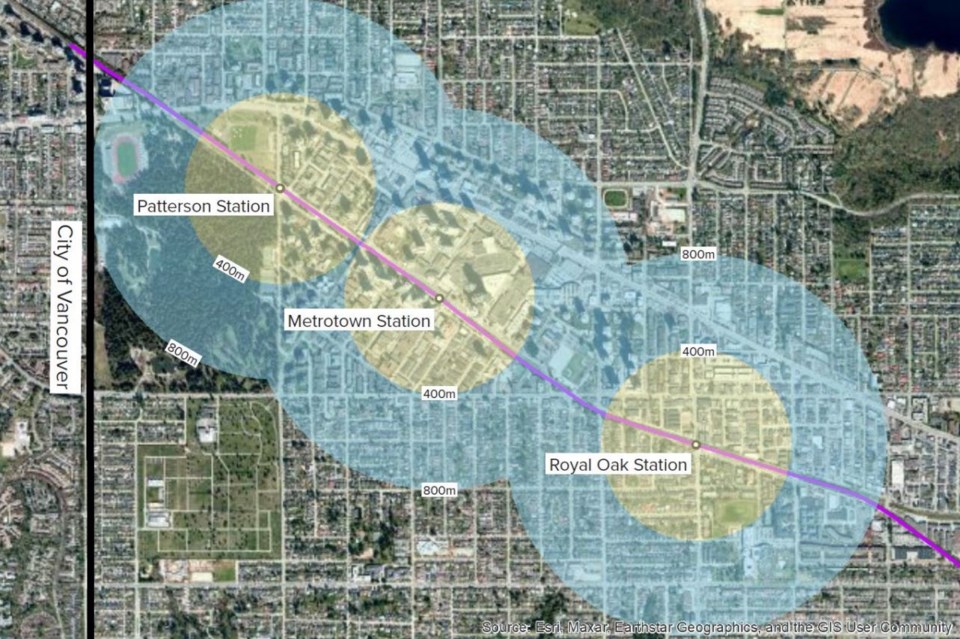The province’s push to clear the path for additional housing at greater densities could end up pushing out many small neighbourhood businesses as upzoning up-ends their viability.
Bill 47, introduced Nov. 8 as part of a suite of bills designed to increase housing affordability, would effectively double the density allowed in “transit-oriented areas” and remove height restrictions on residential construction across the province.
While not yet designated, the bill would give the lieutenant governor authority to designate “bus stops, bus exchanges, passenger rail stations and other transit facilities for the purposes of the definition of ‘transit station.’”
This means cities from Victoria to Vernon and north to Fort St. John could be impacted.
While the province’s Assessment Act protects homeowners from the blanket upzoning of single-family lots to permit four-plexes and six-plexes as proposed in Bill 44, introduced Nov. 1, there is no such protection for non-residential properties.
“There is no protection,” said Paul Sullivan, principal and regional leader in the Vancouver office of property tax and software provider Ryan ULC. “We all know about this highest-and-best-use problem, and it’s like, ‘Look out small business, you’re going to be hammered.’”
The problem of highest-and-best-use is one that played out in Richmond when city council designated a swathe of industrial property for future residential development in the mid-2000s. BC Assessment pegs values on properties based on their highest and beset use, but they’re taxed at current use – and for businesses, that’s multiples of what the residential tax rate is.
“On the 2025 taxes, we’re going to see substantial escalations on land values around commercial nodes and your local, independent businesses are going to be paying the bills,” Sullivan said.
Many small businesses have found it tough enough paying their existing property taxes in recent years, and the burden of street crime, shoplifting and shifting consumer spending patterns in the wake of the pandemic has made life harder than ever.
“Post-pandemic, small business is not doing well,” Sullivan said. “My preliminary review shows a drastic decline in the number of small businesses in Vancouver.”
While the city piloted a Development Potential Relief Program earlier this year that gave property owners a break on the municipal portion of taxes levied on up to $5.4 million in upzoned value, just 1,360 of approximately 17,000 properties in the eligible property classes qualified.
It was a good start, but the prospect of Bill 47 shows that more needs to be done to ensure neighbourhood businesses aren’t sideswiped off the street.
“We’ve got to put it to a meaningful level such that the tax savings make a difference because of the extreme values that are going to be created,” Sullivan said.
“It’s going to put a fire on as far as land investment,” said Jason Turcotte, president of Darwin Properties Ltd., a residential developer based in North Vancouver. “It’s taking away a big part of the uncertainty around the entitlement process, being able to identify sites around transit nodes.”
He points out that it won’t be just the expanding SkyTrain corridors of the Lower Mainland that are impacted but cities around the province.
“The housing situation is not just a Lower Mainland issue. It’s across the province. Every part of our province is experiencing a shortage, so certainty and an increase in density will open up opportunity,” he said. “There are many locations – and Kelowna and Kamloops are good examples – where there’s going to be a significant increase in density around some of these areas that are well served by transit that gives developers the opportunity to actually assemble sites for the production of new housing.”
Just how it plays out will depend on the regulations developed to give force and effect to the bill, if and when it passes.
“There will inevitably be a number of groups that have been sitting, biding their time to jump back in terms of their investment decisions, and that’s a catalyst right there in my mind that will spur on investment activity and land sales.
“The proof will be in the pudding when they come out with the detailed regulations, as to how they execute this,” Turcotte said. “We haven’t seen the regulations, but I suspect that when we do there’ll be a greater amount of activity around those hubs.”



